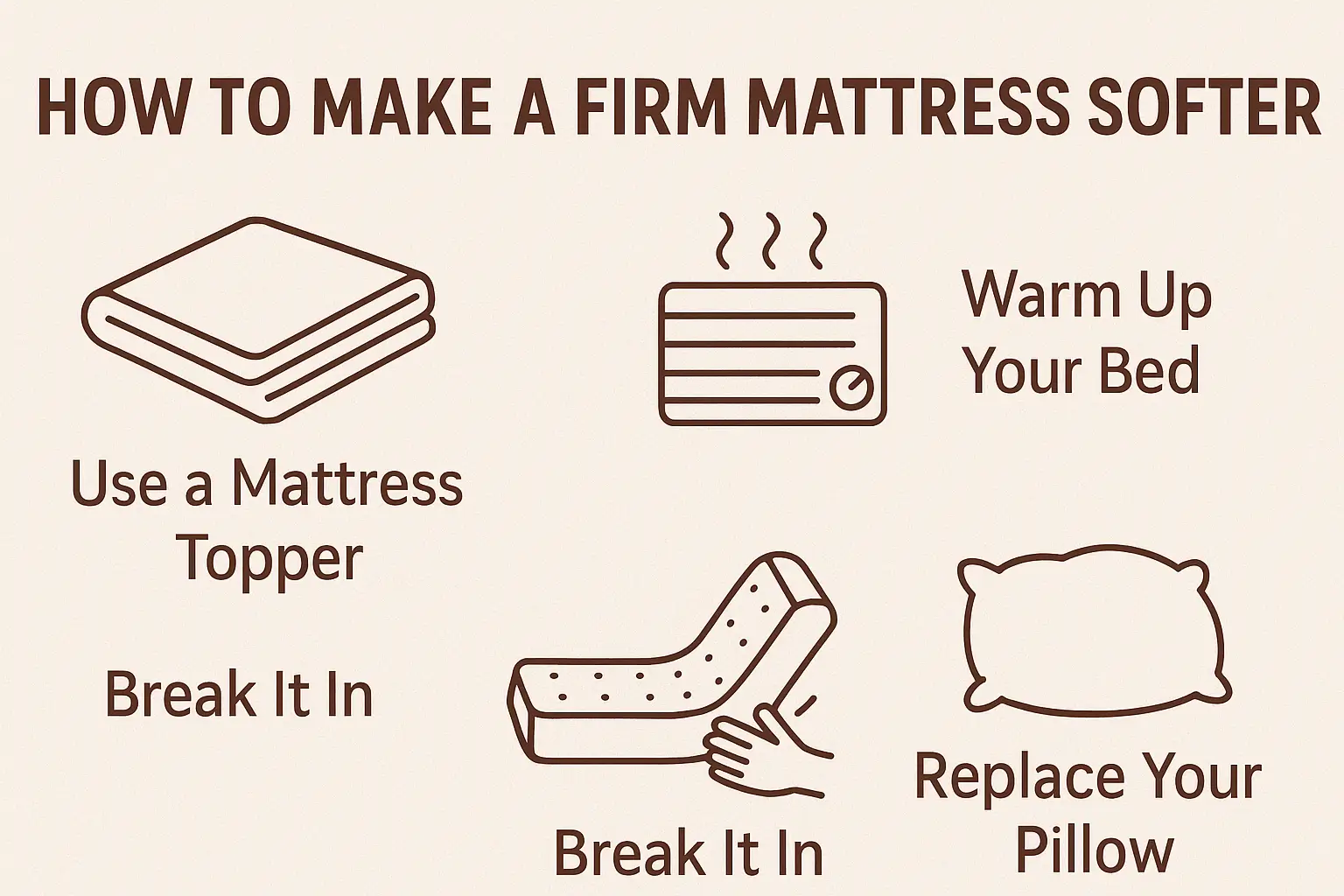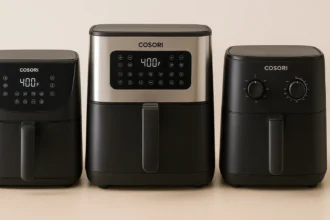Sleeping on a mattress that feels more like a wooden plank than a cozy cloud? You’re not alone. Plenty of folks myself included have faced this dilemma after buying a mattress that seemed like a good idea at first… until night one. The good news? You don’t have to shell out for a whole new bed. There are actually some budget-friendly, tried-and-true ways to How to Make a Firm Mattress Softer and start sleeping better—tonight.
- Why Is Your Mattress So Dang Firm?
- 10 Way to How to Make a Firm Mattress Softer
- 1. Add a Plush Mattress Topper
- 2. Break It In Faster (Walk On It!)
- 3. Warm Up Your Bedroom
- 4. Use a Soft Fitted Mattress Pad
- 5. Flip or Rotate Your Mattress
- 6. Layer Blankets or Comforters Under the Sheet
- 7. Check Your Bed Frame & Foundation
- 8. Sleep in a Different Position
- 9. Use a Body Pillow or Extra Cushions
- 10. Upgrade to a Softer Mattress—If All Else Fails
- Final Thoughts: You Don’t Have to Settle for Stiff Sleep
Whether you’re breaking in a new mattress that hasn’t loosened up yet or trying to salvage an older one that’s just too stiff, I’ve tested and researched the best methods to help you get comfier sleep without the hassle. Below, we’ll cover 10 real fixes that actually work—backed by personal experience, sleep experts, and honest pros and cons.
This post may contain affiliate links. As an Amazon Associate, I earn from qualifying purchases—at no extra cost to you. Thanks for supporting honest, helpful content!
Why Is Your Mattress So Dang Firm?
Before we dive into fixes, let’s talk about why your mattress feels too firm in the first place:
- New mattresses take time to break in—especially memory foam or hybrid models.
- Cold weather can make memory foam feel firmer than usual.
- Firm support layers with thin comfort layers up top = hard sleeping surface.
- Body type & sleep position matter—lightweight side sleepers often feel more pressure on firm beds.
Pro tip: If your mattress is less than 100 nights old, check the return or trial period. Most brands offer risk-free returns, and sometimes a swap for a softer model is a no-brainer.
Also Read : 03 Best Bed Sheets for Hot Sleepers – Buyer’s Guide
10 Way to How to Make a Firm Mattress Softer
1. Add a Plush Mattress Topper
Let’s start with the easiest, most popular fix: a mattress topper.
A soft, high-quality topper can dramatically change the feel of your bed without affecting its support underneath. I personally swear by a 3-inch memory foam topper—it’s the sweet spot for pressure relief without sinking.
Top Picks:
- 🛏 ViscoSoft 3-Inch Memory Foam Topper
✅ Plush yet supportive
✅ Breathable bamboo cover
✅ Great for side sleepers - 🌿 Sleep On Latex Pure Green Topper (Soft)
✅ Natural latex
✅ Durable & cooler than memory foam
✅ Eco-conscious pick
Pros:
- Immediate comfort boost
- Cheaper than buying a new mattress
- Easily removable or replaceable
Cons:
– Adds height (may need deep-pocket sheets)
– Won’t fix a sagging mattress—just softens the surface
2. Break It In Faster (Walk On It!)
This might sound odd, but gently walking or crawling on your mattress can help break it in faster. Just like breaking in new shoes, foam and other materials soften with use.
How to do it safely:
- Remove bedding
- Walk evenly across the surface (avoid heels or sharp pressure)
- Repeat daily for a week or two
Bonus tip: If it’s foam, turn up the heat a bit in your room. Warmer temps help the material flex and soften.
3. Warm Up Your Bedroom
Cold room = stiff mattress. If you’ve got a memory foam bed, temps below 68°F can make it feel rock-hard.
Quick Fix:
Use a space heater (safely!) or bump up your thermostat. Even a heated blanket for 10–15 minutes before bed can do wonders.
Pros:
- Easy, fast comfort boost
- Also helps you fall asleep faster in winter
Cons:
– Not a year-round solution
– Watch your energy bill
4. Use a Soft Fitted Mattress Pad
Not quite as thick as a topper, but a quilted mattress pad can make a subtle yet noticeable difference—especially on newer mattresses that are just slightly too firm.
Look for pads with down alternative fill for that pillow-top feel.
Great Option:
🛌 LEISURE TOWN Cooling Mattress Pad – soft, breathable, and fits mattresses up to 21” deep.
5. Flip or Rotate Your Mattress
Not all mattresses are flippable—but if yours is, try flipping it to see if the other side feels softer. For non-flippable beds, rotating 180° can redistribute wear and sometimes improve pressure points.
Good for:
- Uneven wear spots
- Body impressions
- Older hybrid or innerspring models
6. Layer Blankets or Comforters Under the Sheet
This is a quick DIY hack I tried in a pinch: lay a thick, soft blanket or folded comforter directly on top of the mattress (under the fitted sheet). Adds a cushiony layer without spending a dime.
Pros:
- Free fix
- Great short-term solution for guests or travel
Cons:
– Shifts easily
– Not as durable or consistent as a topper
7. Check Your Bed Frame & Foundation
Sometimes, the issue isn’t the mattress—it’s what’s underneath.
Slatted frames without enough slats can make a mattress feel firmer or uneven. If your mattress is on a platform with no give, try adding a bunkie board or a thin layer of plywood with a topper to soften the overall feel.
8. Sleep in a Different Position
This one’s more personal, but worth a mention. Side sleepers often feel pressure on firm beds. Switching to back or stomach sleeping can reduce that “brick wall” sensation.
Not ideal for everyone, but if you’re a side sleeper struggling with shoulder or hip pain, a soft topper plus some sleep position adjustments might help.
9. Use a Body Pillow or Extra Cushions
Sometimes it’s not the mattress itself, but how your body interacts with it.
Adding a body pillow between your knees or behind your back can redistribute pressure and make a firm mattress feel more comfortable—especially if you sleep on your side.
10. Upgrade to a Softer Mattress—If All Else Fails
If you’ve tried the above and still dread bedtime, it might be time for a mattress that actually suits your sleep style.
Look for:
- Medium-plush memory foam or hybrid options
- At least a 100-night trial
- Return-friendly policies
Brands like Nectar, WinkBed (Softer model), and Nolah offer softer models specifically for side sleepers and lightweight folks.
Not ready to commit? Try a plush topper first to test out what “soft” really feels like for you.
Final Thoughts: You Don’t Have to Settle for Stiff Sleep
There’s no rule that says you have to suffer through a mattress that’s too firm. Whether your bed is brand new or just not the right fit, these real-world, affordable fixes can make a huge difference in comfort—often overnight.
Personally, a quality 3-inch topper plus a slight room temperature boost changed the game for me. Sleep went from “meh” to melting-into-bed cozy in just a few nights.
Remember: comfort is personal, and what works for one sleeper might not work for another. But if you’re waking up sore, stiff, or cranky, give one (or more) of these tips a try—and let me know what worked for you!
Disclosure: Some links in this post are affiliate links, which means I may earn a small commission if you click through and make a purchase. This supports my blog and helps me keep sharing real, helpful content. Thanks for your support!




